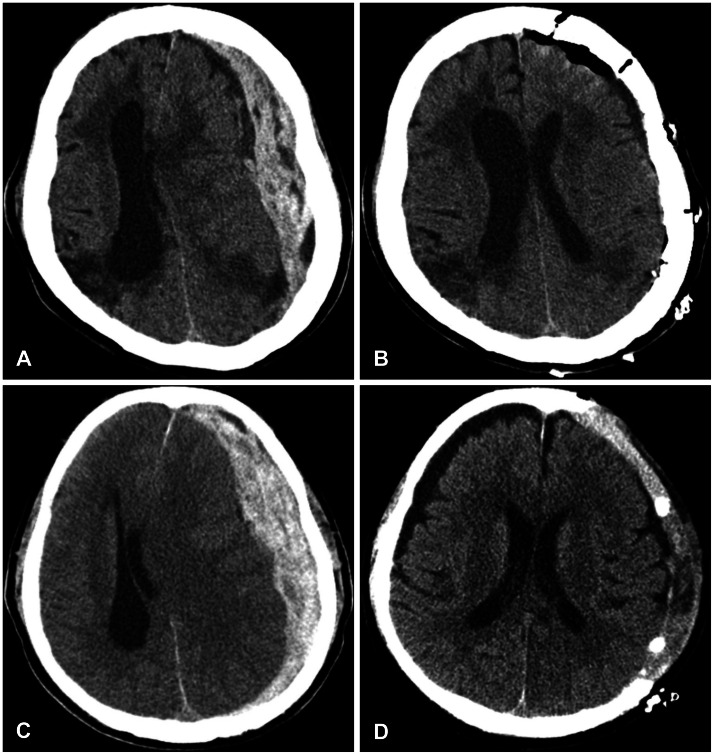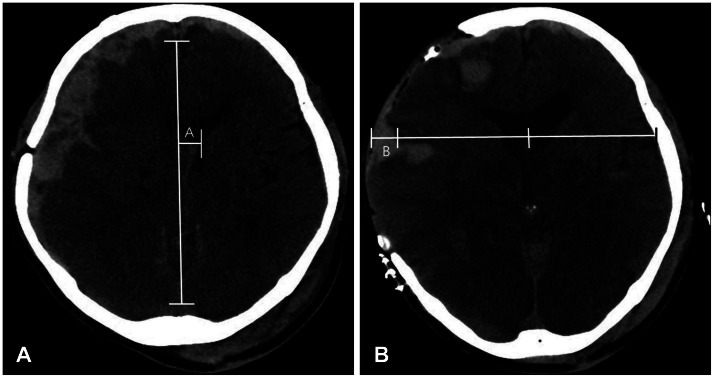Korean J Neurotrauma.
2016 Apr;12(1):22-27. 10.13004/kjnt.2016.12.1.22.
Craniotomy or Decompressive Craniectomy for Acute Subdural Hematomas: Surgical Selection and Clinical Outcome
- Affiliations
-
- 1Department of Neurosurgery, National Health Insurance Service Ilsan Hospital, Goyang, Korea. mduno@hanmail.net
- 2Department of Neurosurgery, School of Medicine, Kangwon National University, Chuncheon, Korea.
- KMID: 2163011
- DOI: http://doi.org/10.13004/kjnt.2016.12.1.22
Abstract
OBJECTIVE
Craniotomy (CO) and decompressive craniectomy (DC) are two main surgical options for acute subdural hematomas (ASDH). However, optimal selection of surgical modality is unclear and decision may vary with surgeon's experience. To clarify this point, we analyzed preoperative findings and surgical outcome of patients with ASDH treated with CO or DC.
METHODS
From January 2010 to December 2014, data for 46 patients with ASDH who underwent CO or DC were retrospectively reviewed. The demographic, clinical, imaging and clinical outcomes were analyzed and statistically compared.
RESULTS
Twenty (43%) patients underwent CO and 26 (57%) patients received DC. In DC group, preoperative Glascow Coma Scale was lower (p=0.034), and more patient had non-reactive pupil (p=0.004). Computed tomography findings of DC group showed more frequent subarachnoid hemorrhage (p=0.003). Six month modified Rankin Scale showed favorable outcome in 60% of CO group and 23% of DC group (p=0.004). DC was done in patient with more unfavorable preoperative features (p=0.017). Patients with few unfavorable preoperative features (<6) had good outcome with CO (p<0.001).
CONCLUSION
In selective cases of few unfavorable clinical findings, CO may also be an effective surgical option for ASDH. Although DC remains to be standard of surgical modality for patients with poor clinical status, CO can be an alternative considering the possible complications of DC.
MeSH Terms
Figure
Cited by 1 articles
-
Predictable Values of Decompressive Craniectomy in Patients with Acute Subdural Hematoma: Comparison between Decompressive Craniectomy after Craniotomy Group and Craniotomy Only Group
Hyunjun Kim, Sang-Jun Suh, Ho-Jun Kang, Min-Seok Lee, Yoon-Soo Lee, Jeong-Ho Lee, Dong-Gee Kang
Korean J Neurotrauma. 2018;14(1):14-19. doi: 10.13004/kjnt.2018.14.1.14.
Reference
-
1. Bullock MR, Chesnut R, Ghajar J, Gordon D, Hartl R, Newell DW, et al. Surgical management of acute subdural hematomas. Neurosurgery. 2006; 58(3 Suppl):S16–S24. discussion Si-SivPMID: 16710968.
Article2. Chaturvedi J, Botta R, Prabhuraj AR, Shukla D, Bhat DI, Devi BI. Complications of cranioplasty after decompressive craniectomy for traumatic brain injury. Br J Neurosurg. 2016; 30:264–268. PMID: 26083136.
Article3. Chen SH, Chen Y, Fang WK, Huang DW, Huang KC, Tseng SH. Comparison of craniotomy and decompressive craniectomy in severely head-injured patients with acute subdural hematoma. J Trauma. 2011; 71:1632–1636. PMID: 22027888.
Article4. Chibbaro S, Marsella M, Romano A, Ippolito S, Benericetti E. Combined internal uncusectomy and decompressive craniectomy for the treatment of severe closed head injury: experience with 80 cases. J Neurosurg. 2008; 108:74–79. PMID: 18173313.
Article5. Coplin WM, Cullen NK, Policherla PN, Vinas FC, Wilseck JM, Zafonte RD, et al. Safety and feasibility of craniectomy with duraplasty as the initial surgical intervention for severe traumatic brain injury. J Trauma. 2001; 50:1050–1059. PMID: 11426120.
Article6. Girotto D, Ledić D, Bajek G, Jerković R, Dragicević S. Efficancy of decompressive craniectomy in treatment of severe brain injury at the Rijeka University Hospital Centre. Coll Antropol. 2011; 35:255–258. PMID: 22220447.7. Girotto D, Ledić D, Daji V, Vujković Z, Mihelcić N. Neurosurgical procedure for treatment of traumatic subdural hematoma with severe brain injury: a single center matched-pair analysis. Coll Antropol. 2014; 38:1255–1258. PMID: 25842771.8. Godlewski B, Pawelczyk A, Pawelczyk T, Ceranowicz K, Wojdyn M, Radek M. Retrospective analysis of operative treatment of a series of 100 patients with subdural hematoma. Neurol Med Chir(Tokyo). 2013; 53:26–33. PMID: 23358166.
Article9. Gooch MR, Gin GE, Kenning TJ, German JW. Complications of cranioplasty following decompressive craniectomy: analysis of 62 cases. Neurosurg Focus. 2009; 26:E9. PMID: 19485722.
Article10. Honeybul S. Complications of decompressive craniectomy for head injury. J Clin Neurosci. 2010; 17:430–435. PMID: 20181482.
Article11. Honeybul S, Ho KM. Decompressive craniectomy for severe traumatic brain injury: the relationship between surgical complications and the prediction of an unfavourable outcome. Injury. 2014; 45:1332–1339. PMID: 24704150.
Article12. Huang AP, Tu YK, Tsai YH, Chen YS, Hong WC, Yang CC, et al. Decompressive craniectomy as the primary surgical intervention for hemorrhagic contusion. J Neurotrauma. 2008; 25:1347–1354. PMID: 19061378.
Article13. Kalayci M, Aktunç E, Gül S, Hanci V, Edebali N, Cagavi F, et al. Decompressive craniectomy for acute subdural haematoma: an overview of current prognostic factors and a discussion about some novel prognostic parametres. J Pak Med Assoc. 2013; 63:38–49. PMID: 23865130.14. Karibe H, Hayashi T, Hirano T, Kameyama M, Nakagawa A, Tominaga T. Surgical management of traumatic acute subdural hematoma in adults: a review. Neurol Med Chir (Tokyo). 2014; 54:887–894. PMID: 25367584.
Article15. Li LM, Kolias AG, Guilfoyle MR, Timofeev I, Corteen EA, Pickard JD, et al. Outcome following evacuation of acute subdural haematomas: a comparison of craniotomy with decompressive craniectomy. Acta Neurochir (Wien). 2012; 154:1555–1561. PMID: 22752713.
Article16. Liang ES, Tipper G, Hunt L, Gan PY. Cranioplasty outcomes and associated complications: a single-centre observational study. Br J Neurosurg. 2016; 30:122–127. PMID: 26328774.
Article17. Meier U, Gräwe A. The importance of decompressive craniectomy for the management of severe head injuries. Acta Neurochir. 2003; 86(Suppl 86):367–371.
Article18. Ransohoff J, Benjamin MV, Gage EL Jr, Epstein F. Hemicraniectomy in the management of acute subdural hematoma. J Neurosurg. 1971; 34:70–76. PMID: 5539647.
Article19. Servadei F. Prognostic factors in severely head injured adult patients with acute subdural haematoma's. Acta Neurochir (Wien). 1997; 139:279–285. PMID: 9202766.
Article20. Winter CD, Adamides A, Rosenfeld JV. The role of decompressive craniectomy in the management of traumatic brain injury: a critical review. J Clin Neurosci. 2005; 12:619–623. PMID: 16033709.
Article21. Woertgen C, Rothoerl RD, Schebesch KM, Albert R. Comparison of craniotomy and craniectomy in patients with acute subdural haematoma. J Clin Neurosci. 2006; 13:718–721. PMID: 16904897.
Article22. Yanaka K, Kamezaki T, Yamada T, Takano S, Meguro K, Nose T. Acute subdural hematoma--prediction of outcome with a linear discriminant function. Neurol Med Chir (Tokyo). 1993; 33:552–558. PMID: 7692328.
- Full Text Links
- Actions
-
Cited
- CITED
-
- Close
- Share
- Similar articles
-
- Acute Subdural Hematomas Review of 100 Cases
- Paradoxical Herniation after Decompressive Craniectomy for Acute Subdural Hematoma
- Emergent Clipping without Prophylactic Decompressive Craniectomy in Patients with a Large Aneurysmal Intracerebral Hematoma
- Predictable Values of Decompressive Craniectomy in Patients with Acute Subdural Hematoma: Comparison between Decompressive Craniectomy after Craniotomy Group and Craniotomy Only Group
- Surgery for Bilateral Large Intracranial Traumatic Hematomas: Evacuation in a Single Session



